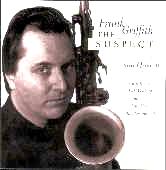|
|
||
|
Technical |
||
Frank Griffith |
||
| Serial Writing | ||
THE
SUSPECT
Frank
Griffith is the chief arranger for the Pete Cater Big Band. If he isnít,
then he should be, for he has composed and arranged most of the titles
on Peteís remarkable new CD Playing
with Fire. Frank hails from New York and studied composing with Bob Mintzer and Bill Finegan. This
is a stunning piece of scoring. Itís impossible to give it full credit
on paper: this one has to be heard to be believed. The main theme and
introduction are worth studying. Example
1 shows the main
theme, played by unison saxes. This is not pure serial writing, but,
there again, pure serial writing does not leave one much scope in jazz
scoring. Sooner or later it has to be abandoned, but itís great for
composing new themes. All
the tones of the twelveĖtone scale are used right up to the E natural
marked with an arrow in bar 9. Some of them are used more than once.
Note the avoidance of any direct tritones, with the exception of one
between bars 6 and 7, where the B and F pull the Db13 into the Cm9 chord.
There are concealed tritones in bars 9 and 10, but they are separated
by other tones and do not influence the flow of progression towards
the final Cm9 in any way. Apart from that, at this tempo I doubt whether
anything could disturb the flow. Itís a point worth watching, though,
in serial composition. Bars
1 to 3 contain all tones of the Cm9 scale; bars 4 and 6 all the added
tones of their respective chords. Example
2 is the intro
of the piece and Iím now going to analyse it. I donít want to get too
clever about this because I once experienced something that taught me
to be very careful indeed in such matters. I heard a musicologist go
into great detail about why Igor Stravinsky had written a certain note
in one of his masterpieces, enthusing over the great
daring, keen aural perception and superb harmonic innovation surrounding
the inclusion of the note. In a subsequent programme an eminent conductor
asked Stravinsky to take a look at this same note, because it had worried
him for quite some time. Igor put on his glasses, frowned and said,
ĎItís a wrong note.í Maybe it was the controversial D he included in
the final A major chord of Mass.
That sure is a weird one. Iíve
put brackets over the relevant bits taken from the main theme of The
Suspect. Some of them have been manipulated slightly but
most of them should be easy enough to recognise. Some of the similarities
are rhythmic only. One passage uses the notes in a slightly different
order in the R of I (Retrograde of Inversion), another serial writing
trick. This is where you write the melody backwards, then invert the
intervals to get a new melody line. The tones are then numbered and
shuffled about. Iíll let you work that one out for yourselves. There
is a repeated pedal point bass line to the intro that, however, plays
no part in this analysis. Snatches
of the theme and rhythmic phrases, variations and inversions taken from
the intro are to be found throughout the score, in the best tradition
of classical composition. They tend to reassure the listener when they
pop up: he knows heís heard that song before somewhere. If
you donít yet have the recording try writing Example
2 with your scoring software, set the sounds to clarinet, alto,
tenor and the tempo to 224. Youíll be amazed at how close you can get
to the original.
|
||
